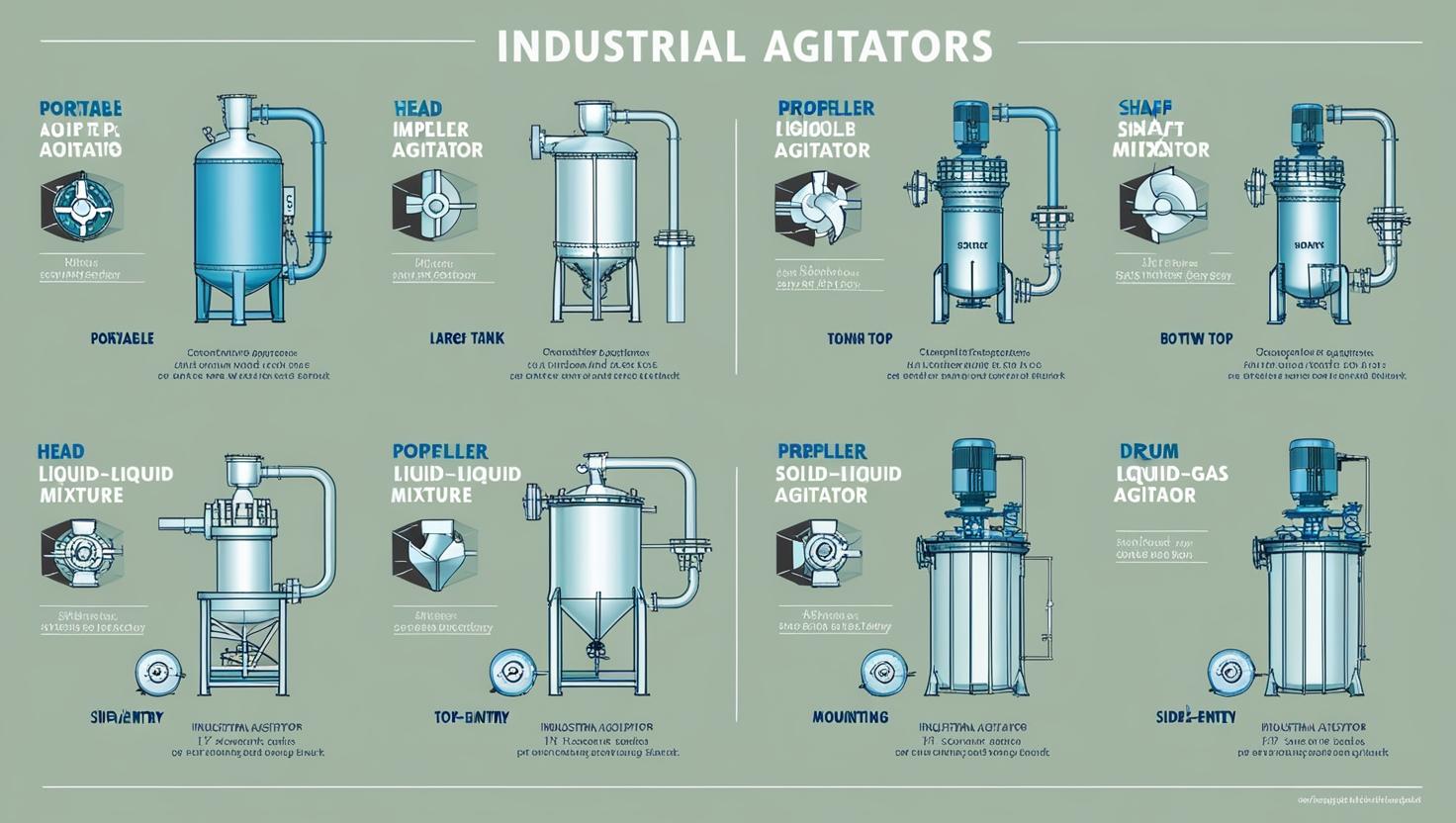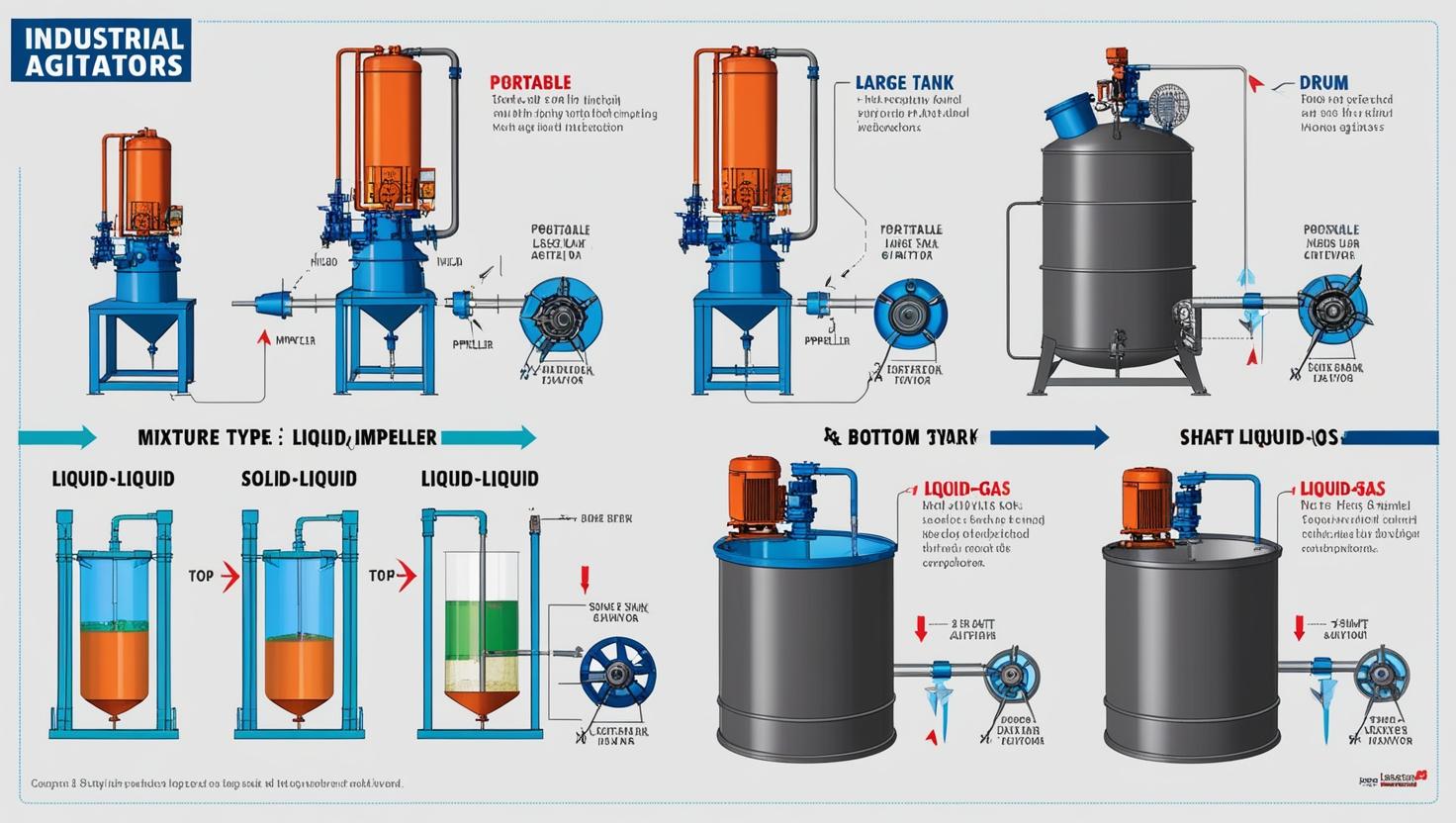The industrial agitators market scope is experiencing significant growth, driven by the increasing demand for efficient and advanced mixing solutions across various industries. Agitators are crucial in mixing, blending, and homogenizing substances in applications such as chemical processing, pharmaceuticals, food and beverages, wastewater treatment, and more. With industries continuously evolving and striving for higher productivity and efficiency, the scope of the industrial agitators market is expanding, resulting in new opportunities for manufacturers and users alike.
This article explores the factors driving the growth of the industrial agitators market, how different sectors are fueling demand, and what the future holds for the industry.
What Are Industrial Agitators?
Industrial agitators are mechanical devices designed to mix or agitate materials to achieve desired chemical reactions, improve consistency, and enhance the processing of various products. These devices are widely used in industries where the blending or combining of liquids, solids, and gases is essential for the production process.
The market for industrial agitators is vast and covers a range of applications, from simple mixing of fluids in food production to complex chemical reactions in pharmaceutical manufacturing. The core function of an industrial agitator is to enhance the interaction of materials, creating uniformity and preventing the settling of solids.
Key Factors Driving Demand in the Industrial Agitators Market
1. Growth of the Chemical and Pharmaceutical Industries
One of the primary drivers behind the increasing demand for industrial agitators is the growth of the chemical and pharmaceutical industries. In chemical manufacturing, industrial agitators are used for tasks such as emulsification, crystallization, and polymerization. With the rising need for specialty chemicals and biopharmaceutical products, the demand for precise and efficient mixing systems has surged.
The pharmaceutical sector, in particular, relies on agitators for tasks such as drug formulation, mixing active pharmaceutical ingredients (APIs), and ensuring the homogeneity of suspensions and emulsions. As regulatory standards for drug development and production tighten, the need for high-quality industrial agitators capable of achieving consistency and efficiency is also growing.
2. Expansion of the Food and Beverage Industry
The food and beverage industry is another major sector propelling demand for industrial agitators. Agitators play a critical role in food production processes, including the mixing of ingredients, fermentation, emulsification of oils and water, and the blending of sauces, creams, and juices. As consumer preferences shift toward processed and packaged foods, food manufacturers are investing in advanced mixing solutions to improve production efficiency, product quality, and consistency.
Additionally, the demand for more natural, organic, and functional food products requires specialized mixing technologies to handle delicate ingredients without compromising their nutritional value or texture. The growing popularity of plant-based and dietary supplements is also adding to the need for more advanced industrial agitators in the food sector.
The global industrial agitators market is expected to be valued at USD 3.10 billion in 2024 and is projected to reach USD 3.99 billion by 2029; it is expected to grow at a CAGR of 5.2 % from 2024 to 2029.
Download PDF Brochure @
https://www.marketsandmarkets.com/pdfdownloadNew.asp?id=59649096

3. Surging Demand in the Water and Wastewater Treatment Sector
The water and wastewater treatment industry is another significant contributor to the growth of the industrial agitators market. Agitators are widely used in processes such as flocculation, coagulation, and aeration in water treatment plants. As urban populations grow and environmental concerns rise, there is an increasing focus on wastewater treatment and the recycling of water.
In particular, the demand for industrial agitators in the water sector has been rising in response to more stringent environmental regulations and the need for innovative wastewater management systems. The rise of municipal and industrial wastewater treatment plants, as well as the increasing adoption of advanced water purification technologies, is expected to continue driving market growth.
4. Growth of the Oil and Gas Industry
The oil and gas industry is another important market segment for industrial agitators. Agitators are used in various applications such as crude oil refining, drilling fluid mixing, and the blending of chemicals used in enhanced oil recovery (EOR). With increasing global energy demand and technological advancements in oil extraction and refining, the demand for efficient mixing solutions in the oil and gas sector is rising.
As the industry embraces more sustainable practices and moves towards biofuels and renewable energy sources, industrial agitators will play a crucial role in processing these alternative energy sources and ensuring efficient production.
5. Advancements in Agitator Technology
The ongoing technological advancements in agitator designs are also contributing to the market’s growth. Innovations such as the development of high-efficiency agitators that minimize energy consumption, automated systems that offer precise control over mixing, and sanitary agitators for sterile environments in the pharmaceutical and food industries are driving further demand. These technological improvements are increasing the versatility of industrial agitators and opening up new applications in various sectors.
For example, the introduction of magnetic agitators has improved mixing accuracy and reduced the need for mechanical seals, making them suitable for highly viscous and sensitive applications in pharmaceuticals and biotechnology.

Industrial Agitators Market Trends to Watch
1. Increasing Focus on Energy Efficiency
With rising energy costs and environmental concerns, manufacturers are increasingly focusing on creating more energy-efficient agitators. By integrating variable speed drives (VSDs) and smart control systems, industrial agitators can adjust their operating speed according to the mixing requirements, reducing energy consumption and enhancing operational efficiency.
2. Growing Demand for Customization
As industries become more specialized, the demand for customized industrial agitators has increased. Manufacturers are increasingly offering tailored solutions that meet the specific needs of individual applications, whether it’s high-torque mixing for heavy-duty materials or sanitary designs for food and pharmaceutical sectors.
3. Integration of IoT and Automation
The integration of the Internet of Things (IoT) and automation technologies into industrial agitators is another key trend. Smart agitators equipped with IoT sensors can monitor factors such as temperature, viscosity, and agitation speed in real-time, offering greater control and ensuring optimal performance. Automated systems can help reduce human error, improve safety, and increase the overall efficiency of the mixing process.
4. Focus on Sustainability
There is growing pressure from both governments and consumers for companies to adopt sustainable practices. The use of eco-friendly materials in agitator manufacturing, alongside energy-saving features, is becoming a significant trend. This includes using corrosion-resistant materials for longer-lasting equipment and designing agitators that minimize waste generation.
The industrial agitators industry is undergoing rapid growth, fueled by expanding industries such as chemicals, pharmaceuticals, food and beverages, oil and gas, and water treatment. The increasing need for efficient and specialized mixing solutions, driven by technological advancements and the evolving demands of various sectors, is creating vast opportunities in the market.
As industries strive for higher productivity, sustainability, and innovation, the demand for advanced industrial agitators capable of handling complex processes will continue to rise. Manufacturers that can offer customizable, energy-efficient, and technologically advanced agitators are well-positioned to capitalize on the growing market, contributing to the development of smarter and more efficient industrial operations worldwide.
